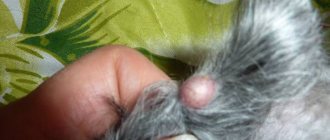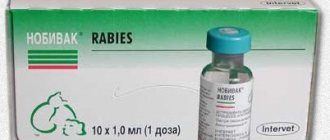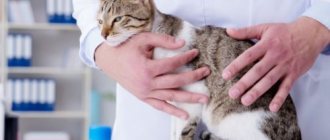Vaccine against feline leukemia Vaccination against feline viral leukemia When to vaccinate cats against leukemia Complications after vaccination against leukemia Feline viral leukemia (feline leukemia Virus or FeLV) is a common infectious disease of cats caused by an RNA-containing retrovirus. The pathological process is associated with the emergence and subsequent malignant proliferation of hematopoietic tissue. In this case, new cell forms are formed, replacing and interfering with the maturation of healthy blood cells. The disease is widespread throughout the world; cats at risk are those living in crowded conditions - in shelters and nurseries, all cats on their own (including country houses). In some cases, cats can fight this virus on their own (eliminate), and resistance also increases with age, however, upon repeated contact with carriers of leukemia, transmission of the disease is quite likely. When clinical signs appear, the prognosis is unfavorable, almost always fatal. In the early stages (from several weeks to several years), the disease can occur latently, without clinical symptoms, what exactly is associated with the activation of the virus is still unknown, but it is known that stress, unfavorable conditions, changes in living conditions and feeding play a role.
Vaccine against feline leukemia
There are several different types of feline leukemia virus vaccines. In Russia, only the recombinant viral vaccine is most often used (manufactured by Purevax, brand name Purevax FeLV). The Feline Leukemia Viral Vaccine is a non-essential vaccine as recommended by WSAVA, but should be recommended for all cats that are at risk of being exposed to infected animals. Most often, cats that can freely walk outside are infected, but even living with a former street cat carries a risk of infection. Therefore, if you have cats that may be carriers of the virus, it is recommended to vaccinate your pets.
In shelters and nurseries, a very careful attitude to the prevention of infection is required; in most cases, leukemia is transmitted to kittens from infected parents.
Transmission, epidemiological data
Contrary to popular belief, in nature the anemia virus is quite widespread and is found almost everywhere. It is transmitted from animal to animal by contact, but aerogenic transmission (with droplets of saliva) cannot be excluded, which makes this pathogen extremely dangerous. Alas, in recent years, cases of transmission through food and urine have been repeatedly recorded. In the works of foreign veterinarians, there are references that fleas can also be carriers of the feline leukemia virus. With all this, pregnant cats “by inheritance” do not transmit the pathogen to their offspring in the womb, and there is no information about its circulation in cat’s milk. In any case, tests do not detect the virus there. However, this does not in any way exclude the possibility of infection through air and saliva (when a mother cat licks her kittens). It should be remembered that any animal, even if it does not have clinical manifestations of the disease, may well be its carrier.
Important! Feline leukemia is transmitted through grooming items, so only use your own equipment at cat shows!
This is what needs to be said here. If some “cat lover” lives in your entrance or a neighboring apartment building, keeping about forty cats (or even more) in the apartment, then the leukemia virus is definitely present in your area. Scientists have proven that animals in large “collections” are much more susceptible to infection. By the way, many breeders are especially interested in one question: is leukemia in cats transmitted to humans or not? We hasten to reassure those who doubt and fear! Transmission of the leukemia virus from cats to humans is completely excluded. Moreover, many doctors now suggest that leukemia in humans is, in principle, caused not by viruses, but by the effects of radiation, chemicals, or poor heredity.
Vaccination against feline leukemia virus
Cats that are already carriers of the FeLV virus cannot be vaccinated. Therefore, before vaccination it is necessary
conducting serological testing for the presence of antibodies to the leukemia virus. It is possible to guarantee that a cat is not a carrier only in relatively rare cases - for example, kittens from parents with negative test results who have not had contact with other animals will also have a negative FeLV status. In our clinic in Moscow, testing is carried out using rapid tests, so it can be carried out immediately on the day of the intended vaccination, it does not take much time.
Treatment and prognosis
To date, there are no drugs that destroy FeLV. Treatment of the disease is aimed at relieving its symptoms. Symptomatic assistance is often effective, allowing the death of an animal to be postponed for several years by maintaining immunity at a level optimal for normal life. The four-legged patient is prescribed immunostimulating drugs such as Interferon and Raltegravir.
Nutrition is important. It must be complete and balanced. All products used to prepare food for a pet must be subjected to heat treatment, which will eliminate the possibility of pathogenic microorganisms entering its weakened body.
With VLK, signs of secondary diseases appear, so treatment should be aimed at stopping them. Blood transfusions and antianemic therapy provide good results. If a tumor is detected in a four-legged patient, chemotherapy is used. When a stable positive result is achieved, regular visits to the veterinarian are required to correct immunostimulating therapy and assess the pet’s health. A sick animal is isolated from others for the rest of its life to prevent infection.
With the intensive development of FeLV, the prognosis of the disease is unfavorable. In some cases, he can be careful and depends on how long it is possible to maintain the animal’s immunity at an optimal level for more or less normal life. However, even with the most favorable prognosis, infected cats live no more than 4 years.
When are cats vaccinated against leukemia?
The first vaccination for cats at risk, especially in shelters, can be recommended to vaccinate kittens as early as 8 weeks of age, with mandatory revaccination after 2-4 weeks.
Primary vaccination against leukemia is always carried out twice with an interval of no more than 4 weeks. If 5-6 weeks pass after the first vaccination, you will need to be vaccinated again and revaccinated after 2-4 weeks, otherwise a sufficiently strong immunity will not be formed. The same rule applies to adult animals - the first vaccination is always double. You can then revaccinate annually. There is information that cats become more resistant to infection with age, and after 3 years they can be revaccinated against FeLV every 3 years. However, clinically significant immunity when vaccinated with the Purevax FeLV vaccine available in Russia was determined to last 12-14 months, so we recommend annual revaccination. Repeated revaccinations (except for the first) are carried out once.
A single primary vaccination against feline leukemia will not provide protection against the disease.
Vaccination is carried out only in clinically healthy animals. Before vaccination, the cat must be examined by a doctor and carried out (at the first vaccination) serological testing. Let us repeat once again that for cats that are already carriers of the virus, vaccination against leukemia is useless (in some cases it may be harmful).
The vaccine is administered subcutaneously.
Video of cat vaccination against leukemia:
Clinical manifestations
Are there any specific signs of leukemia in cats by which you can definitely determine the presence of this pathology in your pet? This is not so simple. Of course, the blood picture for leukemia in cats is quite indicative, since a huge number of immature forms of leukocytes are observed in the smear, but this can only be determined in laboratory conditions. Is it possible to detect the onset of the disease at home? Alas, there are simply no very specific signs. Firstly, you should be concerned if your pet starts to get sick constantly. And it’s especially bad if diseases appear literally “out of nowhere.” This definitely indicates some problems with the immune system, but not necessarily leukemia. Cats with leukemia constantly get fungal and respiratory infections. Unfortunately, these symptoms do not help much, since the same fungal infections “stick” seriously and for a long time, causing a serious decrease in immunity.
Complications after vaccination against leukemia
For cats, complications after vaccination may manifest themselves in the form of a small lump at the site of vaccine administration - it is not dangerous and will disappear on its own after a while. In rare cases, the vaccine may cause individual intolerance (allergic reaction), which is treated symptomatically. This reaction usually appears immediately after the allergen enters the body, so the doctor at the clinic can quickly take action. Another complication typical for cats is post-injection sarcoma, which, unfortunately, can develop at the site of any injection. This is a rare complication (according to various sources, one animal out of 6-12 thousand), however, there are recommendations for vaccination not in the withers area, but in the distal limbs or tail. It is also recommended to change injection sites for vaccinations annually. You can leave information about the localization in the passport so that when revaccinating a year later, there will be no questions about where the cat was vaccinated.
Symptoms of VLK, diagnosis of the disease
In all cases, without exception, leukemia causes a significant weakening of the pet’s immunity. He begins to get sick often. The disease is severe, with complications and relapses. Other symptoms are associated with secondary infections:
- frequent and sudden changes in body temperature for no apparent reason;
- significant decrease in motor activity;
- excessive sleepiness;
- partial or complete loss of interest in food;
- frequent colds;
- disruption of the digestive system (vomiting, diarrhea);
- hypersalivation;
- enlarged lymph nodes;
- anemia of the mucous membranes.
Diagnosis of leukemia is possible only in a veterinary clinic. Diagnostic methods used to make a diagnosis:
| Diagnostic methods | Purpose of the event | |
| Laboratory | Enzyme immunoassay blood test | Determination of the presence of FeLV in the blood. |
| Polymerase chain reaction | Determination of the presence of retrovirus in bone marrow cells. | |
| Clinical blood test | Detection of blood composition disorders and the presence of symptoms of inflammation in the body. | |
| Instrumental | Radiography | Detection of disturbances in the functioning of internal organs and the presence of malignant cells in the body. |
| Ultrasound | ||
| MRI | ||
What kind of disease is this
Viral leukemia is an infection that affects the lymph, blood tissue, brain, and is accompanied by tumor formations. During illness, hematopoietic function is impaired; pathogenic microorganisms that enter the bloodstream infect healthy cells, often spreading throughout the animal’s body.
The virus (hereinafter referred to as VVV) attacks the cat’s immune system and is often accompanied by other viral and bacterial infections.
Did you know? In 1963, the first French astronaut, a cat named Felicette, flew into space. During the flight, Astrocat (as the name is translated) sent impulses to Earth, read by people from electrode implants in his brain. This is how people assessed his condition and health. The furry astronaut survived the flight and returned home safely.











